

by
Larry "Harris" Taylor, Ph.D.
This material is copyrighted and all rights retained by the author. This article is made available as a service to the diving community by the author and may be distributed for any non-commercial or Not-For-Profit use.
All rights reserved.
Among the most often downloaded articles from my diving web site are those related to the physics of gases and buoyancy. Browsing the internet gives one the impression that buoyancy control is some form of an ancient lost art, as opposed to something that used to be a pre-requisite for open water training. Buoyancy control used to be a given, now, for some, it is unfortunately, a mystery. Here, I have amalgamated a number of articles dealing with buoyancy into a practical guide. Much of this is from my Friday Night Review (105 images, 2.2 megs) that I use as a course refresher on the night before first open water training. I leave the physics that gives rise to an understanding of buoyancy to the single most often downloaded article on my site, Archimedes. A Gold Thief and Buoyancy. It is my experience that understanding the simple principles of this "Archimedes" article leads to a more rapid acquisition of the skills necessary to maintain buoyancy control while diving. Often the difference between an absolutely exquisite experience underwater and a dreadful never-want-to-do-this-again nightmare is the mastery of these simple skills. While these skills are simple, they do require supervised in-water time to master. I have never seen in-water comfort occur in less than about 16 hours of pool time (of a 30 hour pool course) and 100 minutes (of about 250 minutes weekend total ) of bottom time on the first weekend of diving. (see The Primitive Brain).
Go To: Home About "Harris" Articles Slides War Stories Editorials Links Fini
Jump To; Nature Of Problem Forget Overweighting Weight Belt Setting Weight Diving
The key to having a good time underwater is knowing how to control buoyancy. Proper buoyancy control is a great example of a practical application of the Easy Diver's philosophy, "Dive with your brains, not your back," 'cause without an understanding of buoyancy (and lots of in-water practice time), lack of buoyancy control makes submergence on scuba an exercise in frustration and over-exertion. Not controlling buoyancy is just plain being miserable. But, having good buoyancy control allows you to float effortlessly, truly in defiance of gravity, in a warm, wonderful world that is a sensual pleasure unique to our sport. Being weightless, I believe, is the essence of the very real "diver's high!"


Nature of the Buoyancy Problem
There are two primary sources of buoyant force that enter the
water with the diver. They are fat tissue and air spaces. The fat problem can be
addressed by proper diet, exercise and lifestyle modifications. The air space
problem can be addressed by merely taking time to evaluate and understand the situation.
The primary source of buoyancy lies in the gas spaces of the wet suit, buoyancy control device or thermal insulation system. The insulating material (wet suit or dry suit underwear) uses trapped gas for insulation. This volume of gas must be compensated for by the addition of weight. The volume of gas (and resultant buoyancy) changes with depth. For wet suited divers, there is very little a diver can do to change this factor. The diver becomes heavy at depth because the water pressure decreases the volume of the trapped gas in the suit and b.c. and this reduces buoyancy of the diver.
When we think about buoyancy, it is easiest to comprehend what is happening if we forget about positive and negative buoyancy 'cause this leads to confusion in thinking and in solving buoyancy related problems. (See Archimedes, A Gold Thief and Buoyancy.) The fastest route to understanding this whole buoyancy business is to remember that buoyancy is a force, always directed towards the surface.


Archimedes Principle states that this upward force is equal in magnitude to the weight of the water displaced by the submerged object. Weight is a downward force directed towards the bottom.
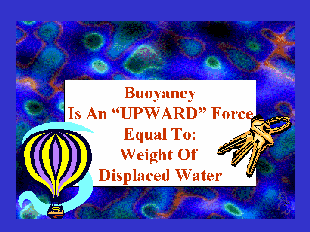
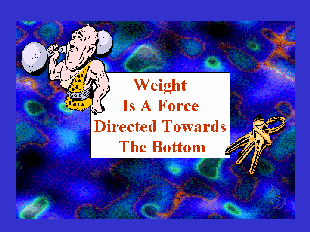
This downward force is equal to the sum of the weight of the diver and everything attached to the diver. So, vertical position of the diver in the water column is primarily the result of two forces acting in direct opposition to each other. Buoyancy moves the diver up in the water column and weight moves the diver down.

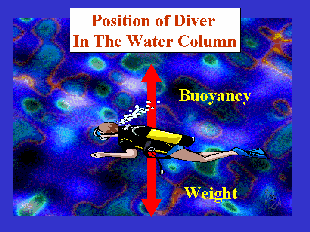
If the forces of buoyancy and weight are balanced, then the desirable "weightless state" (hovering ... just like a helicopter ... there the forces of lift (buoyancy) and weight are balanced. The difference between a helicopter and a diver in this hovering state is that a diver does no work to remain motionless while a helicopter is expending energy spinning its blades to derive the buoyant (lift) force. However, the end result, being stationary in the vertical direction is the same) If these forces are NOT balanced, then work by the diver must be done to remain at a constant depth. Balancing the forces of buoyancy and weight leads to an enjoyable experience.
Before We Start: FORGET OVERWEIGHTING
There is within our sport diving community a disturbing trend to overweight. We are propagating a generation of divers who actually believe the myth that it is necessary to grossly overweight in order to go diving. That myth is simply not true! Dan Orr, of D.A.N., once photographed hundreds of divers in preparation for his slide presentation "Dressed To Kill." He stated, "Over-weighting is a problem that knows no boundaries in experience or certification level." Dan's slide presentation contained numerous "candid" photos of divers who have gone to great (and often bizarre) measures to accomplish this over-weighting. Such extremes included, but were not limited to, strapping large hip weights on scuba cylinders with duct tape, using multiple ankle weights including chains (secured by a padlock), and using duct tape to secure weights on the ankles.
Diving weightless is fun! Crashing into (and destroying) our reefs and/or disturbing everyone's visibility by mucking around on the bottom because of over-weighting, and the forced hard labor associated with an extra weight burden are not fun activities; they are work!
Simply put: Work is the movement of mass through distance. If you carry more weight, you move more mass through the water; thus you will do more work. More work means more air consumed and less bottom time. If you compensate for the extra weight by adding air to the B.C. you increase your drag in the water; thus you do even more work. The over-weighted diver generally adds a lot of air to the B.C. As the diver moves, the air shifts and such divers often feel like they are moving around out of control. (They, of course, are out of control.) The added air poses an additional problem on ascent. The air rapidly expands and increases a diver's ascent rate. An efficient diver tries to minimize work done by streamlining his body; thus an efficient diver moves horizontally through the water. An over-weighted diver generally moves through the water with head higher than feet. This position presents a larger cross-sectional area and creates a lot of drag. Again, the diver must do more work. In this position most of the thrust from the fin is wasted trying to stay level in the water column and forward movement is not as much as it should be. Again, more needless energy is expended. Finally, the extra weight puts a strain on the back and increases risk of out-of-water diver injury.
Adding extra air to compensate for being over weighted at the surface is a recipe for disaster and frustration. The extra volume of gas magnifies the magnitude of buoyancy change as depth varies. This is most apparent near the surface. (Greatest gas volume change per unit depth is in the surface to depth of 12 foot range.) This makes for what I call "yo-yo diving" because the sinking, over weighted diver adds too much gas to the b.c. to overcome the sinking feeling, which then makes the diver rise. The rapidly rising diver dumps rapidly expanding gas to the point of being too heavy and then sinks. This rapid sink-rise "yo-yo" scenario then repeats for many cycles as a frustrated diver tries to cope with inappropriate weighting. Buoyancy control is done best when the volume of gas carried by the diver is at a minimum. This diminishes the magnitude of buoyancy change from changing gas volume as depth varies. (The physics involved in gas expansion is discussed in the second most common download from my site, A Gas Law Primer .)
Bottom line: If you over weighted, then
you will overwork.
Regardless of weighting system used, it is imperative that weight can be easily removed. One way to practice this potentially life-saving skill is to practice removing/dumping the weight belt/system at the end of each dive. Thus, taking off the gear at the end of a dive becomes practice in the art of removing the weight system. If difficulty is encountered in removal of gear, then gear must be rearranged such that removal of weight system is instinctive and done as a reflex. Recreational diving should not be done without the ability to rapidly and completely remove the weight system.
Removal of a weight belt is best done with what I call the "gunslinger method." Both hands go to the thighs. Hands move up the legs and grab the first belt encountered (or find the integrated weight system releases). Ditching a belt is a two handed operation. (The left hand secures the belt, the the right hand releases the buckle). The belt is held out by the left hand at full arms length before dropping to ensure the weight belt drops clean of the diver. (I have personally witnessed weight belt drops done in practice snag diver gear and fin straps. Holding the belt at arm's length allows the belt to drop free of the diver.) Those using integrated systems must remember to use the manufacturer's suggested routine.
The weights on the belt should be balanced, i.e. left and
right sides should be equal so that the diver does not roll to one side because
of more weight on one side or the other. The weight should be as far
forward as possible on the belt. No
weight should be on the back part of the belt underneath the scuba cylinder.
(This shifts the center of buoyancy closer to
the center of mass. Translation: You will be more stable in the water with
lesser tendency to roll. You will be able to remain stationary on the surface
without rolling to one side.) Finally, eliminating the weight underneath the
scuba cylinder makes the belt much easier to ditch in an emergency.
For a 1/4" farmer john wet suit in fresh water, I use the
following procedure to establish proper weighting. Start with 10% of your body weight on
your weight belt. Inflate your
B.C. Enter the water just slightly
deeper than your height WITH A NEARLY EMPTY TANK! (~500 psig). Assume a vertical
position in the water. Take a few
moments to relax. Put the regulator
in your mouth and breathe normally.
Vent your B.C. Your dive buddy/instructor can verify that your B.C. is
empty. You should float at eye level. You should sink as you exhale and rise as
you inhale. If you cannot sink below eye level, add weight in 2-pound increments
until you can float at eye level. If you sink below eye level, then remove
weight in 2-4 pound increments. Since your buoyancy is set with an empty tank,
there will be no problem at the end of your dive in shallow water or holding a
10-15 foot stop because of buoyancy changes caused by the consumption of the
breathing gas. A
full tank will be a few pounds heavier than an empty tank, thus you will
initially enter the water slightly heavy.
Initial descent is then a matter of venting the B.C. and exhaling. This
procedure should be done with each change in equipment configuration. The mark
of a good diver is the ability to dive with a minimum of
weight.
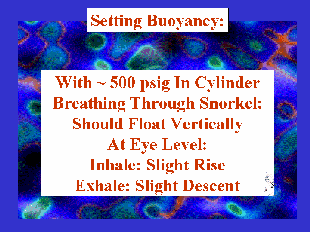
Divers should realize that buoyancy is an individual matter that depends on a number of variables. Buoyancy changes with size (weight gain/loss), body composition (%fat), lung capacity, breathing volume, psychological state (relaxed vs. tense), and exercise load. As these variables change, so will the amount of weight necessary to achieve a hovering state. Since buoyancy changes with time and experience, divers should get in the habit of routinely checking their personal buoyancy requirements.
Bottom line: Setting weights before diving will save frustration and minimize effort required to move through the water column.
The dive should not start until proper weighting as been established.
To descend, we simply look at our buddy, deflate the B.C. and exhale. A common problem in novice divers is to take a deep breath ( the "primitive brain" knows it does not breathe water and is about to submerge, so the natural, human reflex is to deeply inhale on the first descent. However, this inhalation increases lung volume, thereby increasing the volume of displaced water, which increases buoyancy and makes descent more difficult. But, by releasing some air in the b.c. and exhaling, the volume occupied by the diver decreases, buoyancy decreases, and the diver descends 'cause the force of weight (downward force) now exceeds the force of buoyancy (upward force). So, on descent, to slow or stop downward movement, we must either decrease weight or increase buoyancy. Rather than discarding weight (as a balloonist would do to move upward), divers find it convenient (since multiple up and down movements are common on a dive) to increase buoyancy by adding air to the B.C.
We face our buddy during descent because this helps maintain contact (especially in limited visibility water). Facing the buddy also allows instant communication about descent problems like improper weighting or ear equalization difficulties.
As we descend, gas spaces in the diver and the diver's gear will, because of the increased pressure, decrease in volume with a corresponding decrease in upward buoyant force. So, as we descend, SMALL amounts of has are added to the B.C. to provide an upward force to compensate for this lost buoyancy.
The goal is to compensate for, not overcome, the decreasing buoyancy caused by gas volume changes. If you start to rise, you have added too much gas. This will, of course, occur. It takes time to develop a sense of "how much" gas to I add or dump to maintain my position in the water column.
Many divers who have descent problems have failed to drain all
of the gas out of their B.C.'s. Some inexpensive bladder stabilizing vests
actually trap large volumes of gas. This is not a problem with higher quality
jackets. If you are having problems descending, it might be wise to have a buddy
look at your jacket to determine if large air volumes are being trapped between
the bladder and the outer covering. This is the type of situation that is easily
solved: Throw money at the problem (buy a better quality jacket) and the problem
disappears. Often divers do not actually vent all of the gas from their B.C.
Divers should examine their own individual gear and assume a descent position
that places the B.C. vent at the highest possible point. (I personally prefer
B.C.'s that allow gas to be vented in the vertical position by pulling down on
the B.C. hose. This eliminates the need to alter body position to place the vent
at the highest point of the jacket.) It is helpful to have a
buddy/instructor examine descent procedures to determine the optimum venting
position. Descent in this position allows the water pressure to push all of the
gas out of the B.C. (I have seen divers remove 10 lbs of lead, or more, when
they were shown how to properly vent their B.C.'s.)
During the first open water dives, there will be moments where you feel out-of-control. This is because you are truly out-of-control. You see, fine-tuning the balance between the forces of buoyancy and weight, especially during your first experience in a full wet suit takes practice. So, as one force or the other becomes larger, you will move accordingly in the water column. With a bit of time (and that's why I want more than 200 in-water on-scuba minutes the first weekend of diving), your vertical oscillation in the water column will become smaller and smaller. There is no way that you can become comfortable in the water without mastering buoyancy control and that's why we will spend much time in the water. You will be amazed at your comfort level differences between the start of first dive and the end of your fifth dive. (There is no substitute for in-water experience!)
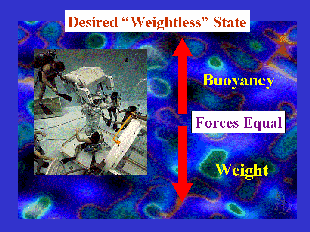
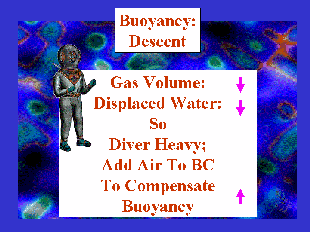
On ascent, gas volume increases, displaced water volume increases, weight is constant (unless dropped) and thus, buoyancy (upward force) increases. To compensate, gas is released from the B.C.. This decreases the air volume in the B.C. which drops the diver + gear displaced volume and so buoyancy decreases. Since the Boyle's law curve is hyperbolic (greater change in volume per unit of ascent is near the surface), left unchecked, the greatest buoyancy increases will be in areas near the surface. So, as divers, we must pay particular attention to our buoyancy as we near the surface. The area near the surface on ascents will be one of the places this weekend where you will need to pay particular attention to your place in the water column.
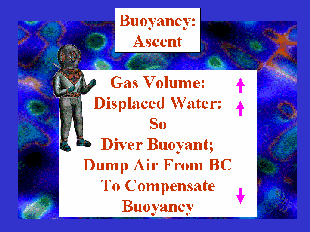
You will definitely notice the thermocline when we hit it. In Michigan fresh water lakes, the first thermocline has a temperature of about 55 oF. When you descend through the thermocline into the decidedly much colder water, the magnitude of buoyancy change that would be present without the temperature difference is increased. The gas temperature drops, so the volume it occupies drops (See Gas Law Primer). So, the displaced volume of water is less (buoyancy decreases) and you will fell heavy ('cause you are!). With practice, this slight buoyancy change in movement into and out of a thermocline will not be a problem. But, it is likely that the first time you experience this transition, the magnitude of change may surprise you. But, like every other in-water skill, a few excursions and this temperature-induced buoyancy shift will not pose a problem.
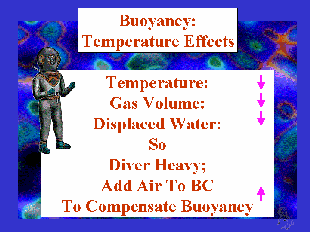
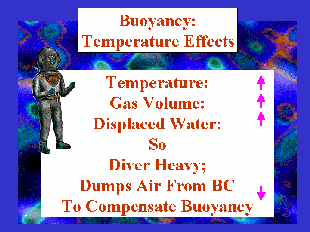
Likewise, when you ascend out of the thermocline into warmer water, the temperature of the gas in your b.c. increases. The gas expands and displaces more water volume and so buoyancy increases. So, when this rise is first felt, dumping gas from the B.C. will compensate.
The natural human (The Primitive Brain) learning curve will be to not respond to the buoyancy changes until there is significant perceived movement. Then there is a tendency to overcompensate. This will lead to "yo-yo diving" in a cycle of buoyancy change and compensation. This can rapidly cover a lot of vertical distance, especially in shallow water where there is the greatest change in gas volume per unit of depth change. (Remember Boyle!) With time and experience, the magnitude of this oscillation will decrease. Also, with experience, slight changes (as in beginning ascent, dropping over an outcropping. entering a thermocline, etc) can be anticipated and compensated for with minimum effort.
Get into the practice of adding or releasing air from the B.C. in small ("baby steps") increments as this technique will minimize the magnitude of in-water depth changes as you learn buoyancy control with your equipment.
Conclusion
I hope by now you have accepted a common theme that underwater skills require time to master and that you will be uncomfortable when submerged until you spend enough in-water time to master the art of buoyancy control.
Jump To: Nature Of Problem Forget Overweighting Weight Belt Setting Weight Diving
Go To: Home About "Harris" Articles Slides War Stories Editorials Links Fini
About The
Author:
Larry
"Harris" Taylor, Ph.D. is a biochemist and Diving Safety Coordinator at the
University of Michigan. He has authored more than 200 scuba related articles.
His personal dive library (See Alert Diver, Mar/Apr, 1997, p. 54) is considered
one of the best recreational sources of information In North America.
All rights reserved
Use of these articles for personal or organizational profit is specifically denied
These articles may be used for not-for-profit diving education